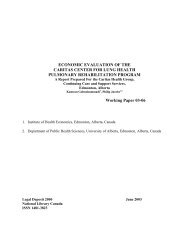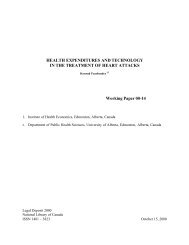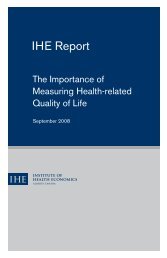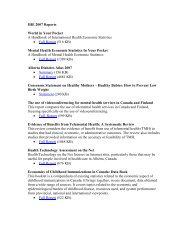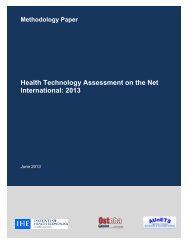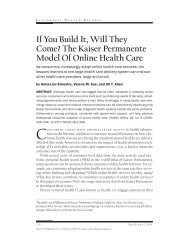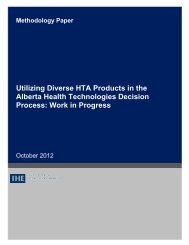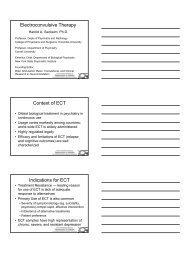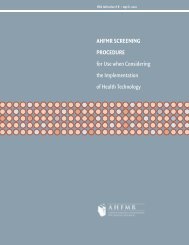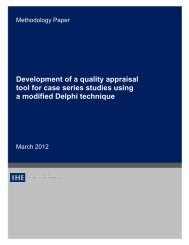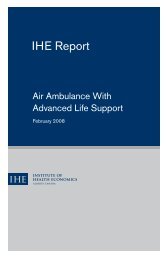etween surgical interventions, the cost per QALY gained was $673 <strong>for</strong> sleeve versus LAGB and$10,714 <strong>for</strong> BPD versus RYGB. Furthermore, RYGB was less effective and more costly comparedto sleeve (that is, sleeve dominated RYGB). At 10 years, 20 years, and lifetime, compared to LM, thecost per QALY gained was $21,595, $13,674, and $9398, respectively, <strong>for</strong> RYGB; and $37,910,$21,240 and $12,212, respectively, <strong>for</strong> LAGB. Furthermore, when the proportion <strong>of</strong> patients with<strong>obesity</strong>-related morbidity was increased, compared to LM, the cost per QALY gained <strong>for</strong> RYGBdecreased. The study concluded that bariatric surgeries were more cost-effective than lifestylemodification <strong>for</strong> the treatment <strong>of</strong> patients with severe <strong>obesity</strong>. However, within surgicalinterventions, it was uncertain which surgical intervention had the greatest cost-effectiveness due tolimitations in available data.Anselmino et al. 4 used a decision analytic model to evaluate the cost-effectiveness <strong>of</strong> adjustablegastric banding (AGB) and gastric bypass procedures (GBP) compared to medically guided diet(conventional treatment) <strong>for</strong> treating obese patients (BMI ≥ 35 kg/m 2 ) with type 2 diabetes (T2DM).The study was conducted from a payer’s perspective over a 5-year time horizon in three Europeancountries (Austria, Italy, and Spain) and included the cost <strong>of</strong> pre-surgery assessment, surgicalprocedures, hospitalization, follow-up, physician visits, and the treatment <strong>for</strong> surgery-relatedcomplications and T2DM. In Austria and Italy, AGB and GBP were less costly and more effectivethan conventional treatment (CT) (that is, they dominated CT). In Spain, compared to CT, the costper QALY gained was $1964 3 <strong>for</strong> AGB and $3593 <strong>for</strong> GBP. The study concluded that compared toCT, AGB and GBP were cost-effective interventions <strong>for</strong> the treatment <strong>of</strong> severely obese patients.Summary <strong>of</strong> CADTH reportNine studies 5-13 were already reviewed by the CADTH report and are summarized below. Thestudies assessed the cost-effectiveness <strong>of</strong> a bariatric surgery in comparison with either anothersurgical alternative or standard care <strong>for</strong> patients with a BMI ≥ 40 kg/m 2 or a BMI ≥ 35 kg/m 2 with<strong>obesity</strong>-related morbidity. The majority <strong>of</strong> these studies took a payer’s perspective; three 8,9,11 took asocietal perspective.For studies that evaluated surgical interventions versus standard care, the cost per QALY gainedranged between $5000 and $40,000, indicating the bariatric surgical interventions were cost-effective.Craig et al. 10 reported the cost-effectiveness ratios <strong>for</strong> GBP by age groups; they ranged from $5646to $16,834 <strong>for</strong> women and $11,188 to $37,223 <strong>for</strong> men. Surgery was the least cost-effective <strong>for</strong>elderly patients. In the study by Salem et al., 6 RYGB was associated with a cost less than $26,140 perQALY gained, as compared to standard care.For obese patients with T2DM, bariatric surgery was found to be more cost-effective than standardcare in two studies. 7,13 Ackroyd et al. 7 reported $2406 per QALY gained <strong>for</strong> LGBP and $3308 perQALY gained <strong>for</strong> LAGB in the UK; in France and Germany, the bariatric interventions were moreeffective and less costly. Keating et al. 13 showed that LAGB was associated with a gain <strong>of</strong> 0.7 lifeyear and 1.2 QALYs at a lower cost ($2614 in savings).For studies that evaluated surgical interventions with other surgical interventions, Paxton et al., 9 vanMastrigt et al., 11 and Clegg et al. 12 provided direct comparisons across bariatric surgical alternatives.Paxton et al. assumed that weight loss was comparable between open gastric bypass andlaparoscopic gastric bypass, and hence conducted a cost-minimization analysis. They reported the3 To facilitate the comparison, all currencies are converted to Canadian dollars using the exchange rates released by theBank <strong>of</strong> Canada on August 11, 2010.Table E.A.2 <strong>for</strong> costs in original currencies.<strong>Bariatric</strong> <strong>treatments</strong> <strong>for</strong> <strong>adult</strong> <strong>obesity</strong> 164
latter to be more cost-effective, driven by fewer post-operative complications, and noted adifference in health care and productivity costs. van Mastrigt et al. 11 compared vertical bandedgastroplasty (VBG) with Lap-Band over a 1-year horizon, based on an RCT enrolling 100 patients.This study indicated that VBG was associated with an extra $143 per additional per cent excessweight loss. In the Clegg study, AGB and gastric bypass were shown to be more cost-effective thanVBG, with a cost <strong>of</strong> $10,131 and $1217, respectively, per QALY gained.In conclusion, the CADTH report 1 stated that, compared to lifestyle modification, bariatric surgerywas cost-effective <strong>for</strong> patients with severe <strong>obesity</strong> and, furthermore, was less costly and moreeffective <strong>for</strong> those with T2DM. However, the report suggested that no conclusion was achievedregarding the cost-effectiveness between the surgical alternatives, due to limitations in the reviewedprimary studies.Pharmacotherapy (PT) versus lifestyle modification (LM), weight management program(WMP), or no treatmentEight studies 14-21 compared PT plus LM with LM alone. Two studies 22,23 evaluated PT alone versusno treatment and one study 24 evaluated PT plus WMP versus WMP alone. Van Baal et al. 14conducted a Markov model to compare low-calorie diet (LCD) alone with no treatment and tocompare LCD plus orlistat with no treatment <strong>for</strong> <strong>adult</strong> patients between 20 and 70 years <strong>of</strong> age witha BMI ≥ 30 kg/m 2 . The analysis was conducted in the Netherlands from a payer’s perspective over alifetime horizon. Estimates <strong>of</strong> short-term efficacy were derived from published literature, and longtermefficacy rates were based on the assumption that 23% <strong>of</strong> weight loss achieved after 1 yearwould be maintained over the patient’s lifetime. This analysis considered the cost <strong>of</strong> health care(including GP and dietitian time), orlistat acquisition, and the treatment <strong>for</strong> <strong>obesity</strong>-related morbidity.Compared with no treatment, the cost per life year gained and the cost per QALY gained were$22,177 and $24,140, respectively, <strong>for</strong> LCD alone, and $72,286 and $79,299 <strong>for</strong> LCD plus orlistat.The study concluded that LCD should be the first option <strong>for</strong> the treatment <strong>of</strong> <strong>obesity</strong> <strong>for</strong> <strong>adult</strong>saged 20 to 70 years with a BMI ≥ 30 kg/m 2 .Lacey et al. 15 constructed a decision-tree model to assess the cost-effectiveness <strong>of</strong> LCD plus orlistat,as compared to LCD alone <strong>for</strong> patients aged 18 years or older with a BMI ≥ 28 kg/m 2 and nodiagnosed T2DM. The analysis was conducted in Ireland from a payer’s perspective using an 11-yearhorizon. Estimates <strong>of</strong> efficacy were derived from five RCTs. The treatment period was 12 months.For patients with less than 5% weight loss at the third month, the orlistat treatment would bediscontinued. Costs considered in the analysis were the acquisition cost <strong>of</strong> orlistat, the cost <strong>of</strong> theLCD program, and the cost associated with monitoring and treatment <strong>of</strong> <strong>obesity</strong>-related morbidity.Compared to LCD alone, the cost per QALY gained was $22,864 <strong>for</strong> LCD plus orlistat. The studyconcluded that orlistat is effective and cost-effective compared to LCD alone.Iannazzo et al. 16 constructed a Markov model to assess the long term (10 years) clinical andeconomic impact <strong>of</strong> orlistat in combination with LM (LCD and exercise) versus LM alone <strong>for</strong> <strong>adult</strong>patients in Italy with a BMI ≥ 30 kg/m 2 . Clinical evidence applied in the analysis was based on alarge RCT, and costing was conducted from a societal perspective. Cost categories included theorlistat acquisition, glucose tolerance test <strong>for</strong> impaired glucose tolerance (IGT), treatment <strong>of</strong>diabetes, and treatment <strong>of</strong> <strong>obesity</strong>. The patients paid the cost <strong>of</strong> the orlistat, while other costs werepaid by the Italian National <strong>Health</strong> Service. The study indicated that orlistat plus LCD and exercisewas associated with a cost <strong>of</strong> $101,564 per QALY gained, compared to LM alone. When orlistat wasgiven only to obese IGT patients, the cost decreased to $28,631per QALY gained. The study<strong>Bariatric</strong> <strong>treatments</strong> <strong>for</strong> <strong>adult</strong> <strong>obesity</strong> 165
- Page 1 and 2:
Alberta STE ReportBariatric treatme
- Page 3 and 4:
Alberta STE ReportBariatric treatme
- Page 5 and 6:
EXECUTIVE SUMMARYSocial and System
- Page 7 and 8:
Three surgical procedures—adjusta
- Page 9:
Costs of Bariatric Surgery and Pote
- Page 12 and 13:
Regulatory status .................
- Page 14 and 15:
TABLES AND FIGURESSection One: Soci
- Page 16 and 17:
ABBREVIATIONSAll abbreviations that
- Page 18 and 19:
LYMmMAMDMUHCNANHLBINHSNICENIHNNHNPH
- Page 20 and 21:
Bariatric physician: a licensed Doc
- Page 22 and 23:
High-density lipoprotein (HDL): a f
- Page 24 and 25:
Very-low-calorie diet (VLCD): a die
- Page 26 and 27:
Additional Internet searches were c
- Page 28 and 29:
This report addresses obesity in ad
- Page 30 and 31:
Many systemic factors have been ide
- Page 32 and 33:
Severe obesity is associated with d
- Page 34 and 35:
eport their height and under-report
- Page 36 and 37:
Also using self-reported data from
- Page 38 and 39:
An examination of overall obesity d
- Page 40 and 41:
Table S.2 presents the associationa
- Page 42 and 43:
• have multiple focal points and
- Page 45 and 46:
The main problem in any weight mana
- Page 47:
food, and a negative body image. As
- Page 50 and 51:
directly causes death. 61 To the ex
- Page 52 and 53:
The addition of a selected pharmaco
- Page 54 and 55:
lack of formal training in nutritio
- Page 56 and 57:
slightly more likely to have prescr
- Page 58 and 59:
selection criteria, have facilities
- Page 60 and 61:
Barriers to using appropriate baria
- Page 62 and 63:
Overview of adult obesityOver the p
- Page 64 and 65:
the need for regular physical activ
- Page 66 and 67:
phenylpropanolamine/25. Sibutramine
- Page 68 and 69:
Complianceand AdherenceDemand andut
- Page 70 and 71:
Aetna Clinical PolicyBulletinswww.a
- Page 72 and 73:
Overweight 123,821 172,971 157,623
- Page 74 and 75:
REFERENCES1. 2006 Canadian clinical
- Page 76 and 77:
34. Gostin LO. Fast and supersized:
- Page 78 and 79:
69. Klarenbach S, Padwal R, Wiebe N
- Page 80 and 81:
105. Hill JO, Thompson H, Wyatt H.
- Page 82 and 83:
141. Ross R, Bradshaw AJ. The futur
- Page 84 and 85:
172. Arkinson J, Ji H, Fallah S, Pe
- Page 86 and 87:
This section will address a set of
- Page 88 and 89:
dietary therapy is to reduce total
- Page 90 and 91:
Additional benefits of exercise ove
- Page 92 and 93:
medications that inhibit intestinal
- Page 94 and 95:
Rimonabant may be considered for pa
- Page 96 and 97:
Long-term complications are specifi
- Page 98 and 99:
Devices used for bariatric surgeryH
- Page 100 and 101:
Description of the Included Systema
- Page 102 and 103:
AEs for sibutramineAs compared to a
- Page 104 and 105:
Evidence on Efficacy/EffectivenessW
- Page 106 and 107:
Table T.7: Effects of behavioural t
- Page 108 and 109:
SurgeryDescription of the included
- Page 110 and 111:
follow-up time was 3 years. Results
- Page 112 and 113:
group as compared to the VBG group.
- Page 114 and 115:
The authors identified many methodo
- Page 116 and 117:
The investigators pointed out that
- Page 118 and 119:
approximately 3 to 5 kilograms. For
- Page 120 and 121:
for studies with a mean age of part
- Page 122 and 123:
Examining whether use of any of the
- Page 124 and 125:
Evidence from placebo-controlled cl
- Page 126 and 127:
colorectal or gastroesophageal or f
- Page 128 and 129:
Web of ScienceISI Interface License
- Page 130 and 131:
AMA Clinical PracticeGuidelineswww.
- Page 132 and 133:
critical appraisal of the included
- Page 134 and 135:
APPENDIX T.B: EXCLUDED STUDIESTable
- Page 136 and 137:
Padwal R, Li SK, Lau DC. Long-term
- Page 138 and 139: Quality subsection 1: At least MEDL
- Page 140 and 141: Quality subsection 5a:Study quality
- Page 142 and 143: Partially reported: The study types
- Page 144 and 145: Table T.C.1: Results of quality ass
- Page 146 and 147: Table T.C.1: Results of quality ass
- Page 148 and 149: APPENDIX T.D: CHARACTERISTICS OF SY
- Page 150 and 151: Table T.D.1: Characteristics of the
- Page 152 and 153: Table T.D.1: Characteristics of the
- Page 154 and 155: Table T.D.2: Characteristics of the
- Page 156 and 157: APPENDIX T.E: EVIDENCE TABLE ON SAF
- Page 158 and 159: Serious surgical complicationsSurgi
- Page 160 and 161: LSGmMAMDNAnssORQoLRCTRDRRRYGBSBPTGV
- Page 162 and 163: Table T.F.1-2: Weight loss - Behavi
- Page 164 and 165: Table T.F.1-4: Weight loss - Surger
- Page 166 and 167: Table T.F.2: Quality of life (QoL)
- Page 168 and 169: Curioni & Lourenco 2005 58Cholester
- Page 170 and 171: Table T.F.3-3: Risk factors/comorbi
- Page 172 and 173: Table T.F.3-5: Long-term effects of
- Page 174 and 175: Maciejewski et al., 2005 65Avenell
- Page 176 and 177: Table T.G.2: Effects of bariatric s
- Page 178 and 179: Table T.G.4: Effects of bariatric s
- Page 180 and 181: 18. Cerulli J, Lomaestro BM, Malone
- Page 182 and 183: 50. Health Canada Drug Product Data
- Page 184 and 185: SECTION THREE: ECONOMIC EVALUATIONC
- Page 186 and 187: Definition of bariatric surgical pa
- Page 190 and 191: concluded that adding orlistat to L
- Page 192 and 193: Weight management program (WMP) ver
- Page 194 and 195: groups. Compared with standard care
- Page 196 and 197: Results from Analysis of Provincial
- Page 198 and 199: DiscussionThe objectives of the eco
- Page 200 and 201: surgical suites, and so on. The bud
- Page 202 and 203: APPENDIX E.A: LITERATURE SEARCH SUM
- Page 204 and 205: CRD Databases(DARE, HTA & NHS EED)h
- Page 206 and 207: Web of ScienceISI Interface License
- Page 208 and 209: NEOS Librarywww.library.ualberta.ca
- Page 210 and 211: Table E.A.2: Evidence table of revi
- Page 212 and 213: ResultHealth outcomesCostsMarginal
- Page 214 and 215: CostsMarginal analysisThe cost anal
- Page 216 and 217: Time Horizon/discount rateCurrency/
- Page 218 and 219: Objectivestudy perspective: society
- Page 220 and 221: ResultHealth outcomesCostsMarginal
- Page 222 and 223: ResultHealth outcomesCostsMarginal
- Page 224 and 225: S4Economic burden of obesityMean co
- Page 226 and 227: 15. Lacey LA, Wolf A, O'shea D, Ern
- Page 228 and 229: Author Contribution StatementsPaula



